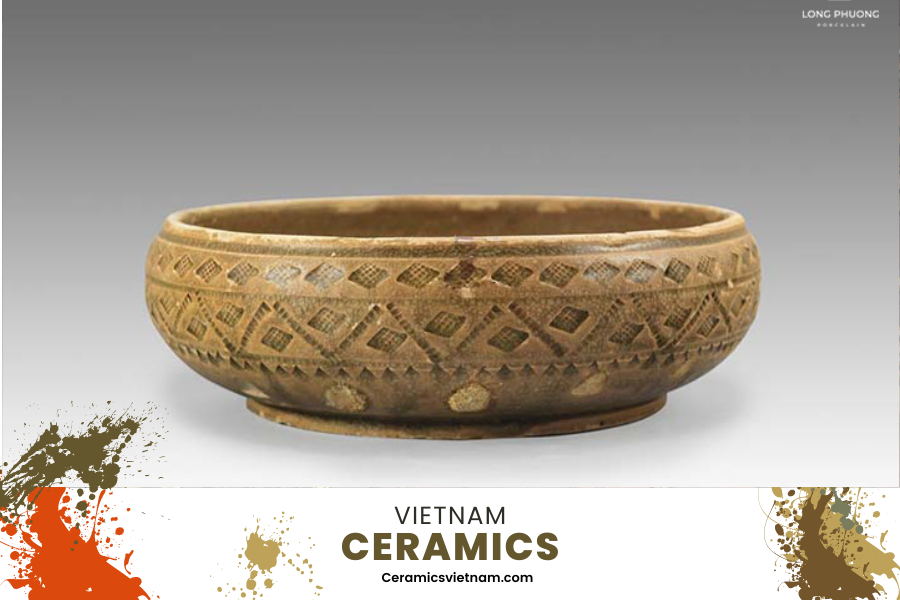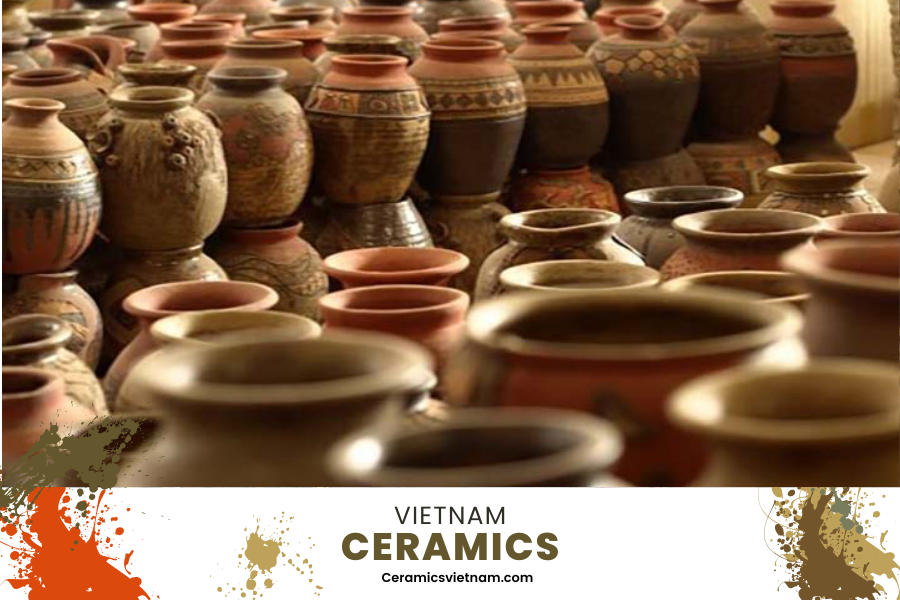The journey of Vietnamese ceramics spans from ancient times to the present day, carrying significant historical and traditional values of Vietnam’s pottery villages. CeramicsVietNam aims to provide readers with a deeper understanding of Vietnam’s ceramic history across different epochs.
Introduction to Ceramics
Ceramics, a versatile and enduring art form, have been an integral part of human culture for millennia. Derived from clay and other natural materials, ceramics encompass a wide range of products, from everyday household items to exquisite works of art.
At its essence, ceramics involve the shaping and firing of clay to create functional or decorative objects. This process, dating back to ancient civilizations, requires skillful craftsmanship and an understanding of materials and techniques.
Ceramics can be broadly categorized into two main types: earthenware and stoneware. Earthenware, typically fired at lower temperatures, results in porous pottery suitable for decorative pieces or everyday utensils. Stoneware, fired at higher temperatures, produces durable and non-porous items ideal for tableware and decorative objects.
Throughout history, ceramics have played various roles in different cultures. They have served as vessels for storage and transportation, symbols of status and wealth, and expressions of artistic creativity. From the intricately painted pottery of ancient Greece to the delicate porcelain of Imperial China, ceramics reflect the values, aesthetics, and technological advancements of their time.
In contemporary society, ceramics continue to thrive as both a traditional craft and a modern art form. Artisans and artists around the world explore innovative techniques and push the boundaries of ceramic artistry, creating unique and captivating pieces that resonate with audiences globally.
Whether displayed in museums, used in everyday life, or cherished as cherished heirlooms, ceramics hold a timeless appeal that speaks to humanity’s creativity, ingenuity, and connection to the natural world
Historical development journey of Vietnamese Ceramics

The emergence and development of Vietnamese pottery through various historical periods
The historical journey of Vietnamese ceramics has traversed hundreds of years of construction, preservation, and development alongside the nation’s progress. Beginning with Vietnamese ceramics in the first ten centuries BC, spanning over 6000-7000 years, new techniques in pottery craftsmanship emerged, swiftly assimilating and evolving with the existing level of expertise and traditional experience to create distinctive nuances. Vietnam became one of the few countries with an early and continuous development in pottery production.
Ceramics have appeared in various regions of the country, experiencing ups and downs throughout history. While many pottery villages continue to thrive and develop, others have gradually declined and disappeared from Vietnam’s ceramic map.
Vietnamese Ceramics through historical periods
Early stage of Vietnamese Ceramics
- Stone Age During this period, pottery materials were typically coarse clay mixed with sand or animal dung. Most pottery pieces were hand-molded, with simple patterns such as diagonal lines, wave patterns, or comb patterns. These patterns were created while the clay was still wet, some made using stamping boards or sharp sticks for drawing or marking. The primary products during this period were containers and cooking vessels, later expanding to include eating utensils and jewelry, with utility being the primary focus.
- Bronze Age After a long period of formation, pottery entered a period of vibrant development, marking the first development phase in Vietnamese ceramic history. Most household ceramic products were boldly shaped on potter’s wheels, resulting in a rich variety of shapes and styles: besides cooking pots, there were jars, pots, bowls, dishes, trays used in dining; earrings, bead necklaces, ceramic jewelry, sculptures of chickens, cows, artistic ceramics.
Ceramics from the Iron Age This period marked the production of earthenware pottery. The clay material was still primitive and less refined compared to contemporary earthenware pottery, but there were no distinctive or rich shaping and decoration techniques. Therefore, when referring to earthenware pottery, the characteristic products are still from the age of the Hung Kings (early Bronze – Iron Age).
Vietnamese Ceramics from the 2nd century BCE From the early 2nd century BCE, Vietnam fell under the domination of Northern feudalism. Due to colonization, the development of ceramics was greatly influenced by Chinese culture. Products with diverse shapes and decorative patterns underwent many changes, still preserving and developing traditional artistic elements from previous eras. Simultaneously, absorbing and nationalizing borrowed elements from the outside.
Independent Period from the 11th to the 14th century From the 10th century, Vietnam entered a period of building independent national feudal states. Ceramic making experienced strong development, playing a crucial role in economic recovery and cultural development, creating a unique identity, diverse forms, and unique artistic decorations.
Ly-Tran ceramics can be divided into three major groups: household ceramics, decorative ceramics, and architectural ceramics.

The emergence and development of Vietnamese pottery through various historical periods
Regarding the shaping of household ceramics, many products were inherited and improved, shaped based on life models such as fruits, shapes of ancient bronze objects.
In terms of decoration, Ly-Tran ceramics had a new turning point. The main motifs were flowers, leaves, birds, elephants, tigers, humans, depicted in a simple, rustic, close-to-nature style typical of Vietnamese nature and people.
Especially in this period, there was significant progress in firing techniques. Craftsmen began to use small kilns, lying kilns, dragon kilns to raise the firing temperature of products from 1200°C to 1280°C.
The development of Vietnamese ceramics during these periods was characterized by independence, exploring decorative themes with a strong indigenous Vietnamese character, creating one of the most brilliant chapters in tradition. Common product types included bowls, cups, pedestals, tea sets, dishes, plates, serving a wide range of purposes from royal to folk life. Particularly, this period saw the formation and development of various types of glazes, such as white glaze, jade glaze, green glaze, brown glaze, brown flower glaze, and by the end of the 14th century, blue flower glaze emerged.
Vietnamese Ceramics from the late 14th century onwards After the 14th century, Vietnamese ceramics seized the opportunity to engage in trade relations with many countries worldwide, greatly impacting handicraft activities, including pottery. Firstly, there was the formation of specialized ceramic production centers: Thang Long, Tho Ha (Hai Bac), Phu Lang (Hai Bac), Huong Cang (Vinh Phuc),…
Ceramics became an important export commodity, with a wide variety of high-quality technical products mainly used for household items, religious items (bowls, dishes, urns, vases, incense burners, sculptures, lamp stands…), typical glazes were blue flowers, many colors, gray-blue, with decorative themes mainly dragons, phoenixes, clouds, kylin…
Vietnamese Ceramics from the 20th century to the present Vietnamese ceramics have developed and inherited many essences from the past: manual kilns have been replaced by modern gas kilns, ensuring mass production. Products vary in design, beautiful patterns, diverse and outstanding.
In conclusion, the formation and development history of Vietnamese ceramics have undergone many ups and downs, changes, and challenges. However, with the dedication and talented hands of craftsmen, along with the passion for ceramic products, Vietnamese ceramics have not only developed domestically but also quickly expanded beyond Vietnam’s borders and gained popularity among international friends and consumers.














Leave a reply